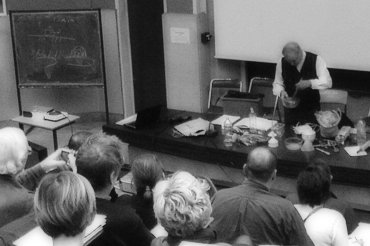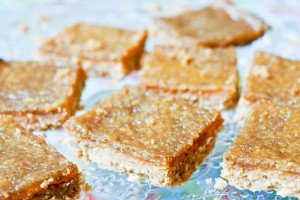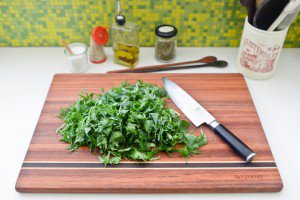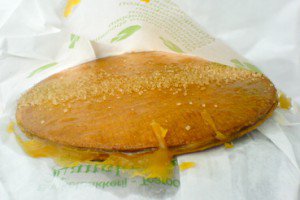
Earlier this week, I attended a two-day conference on molecular gastronomy — sometimes refered to as the “science of deliciousness” — and the relationship between technique, technology, and science.
It was a free and public session, organized by the INRA, the French institute for agricultural research, and the engineering school AgroParisTech. Our lecturer was none other than Hervé This*, co-creator of this scientific discipline that studies the physical and chemical phenomenons that take place in cooking. In passing, 2008 marks the 20th anniversary of molecular gastronomy, and I hear this will be suitably celebrated in Paris around March 20.
I am no longer used to sitting for hours in a cramped classroom, and my right knee made a point of telling me that, but someone like Hervé This makes you want to unearth that satchel and do it all over again: his passion, his enthusiasm, his talent for teaching, and his facetious ways make fourteen hours of lecture go by in a blink.
You should note that Hervé This hosts monthly seminars in Paris — also free and open to the public (by email registration). These are a fantastic opportunity to witness debates and experiments during which you’ll finally get to the bottom of such vital questions as: does adding a potato to an oversalted soup have any sort of effect? Should one beat meat to tenderize it? Do hand-cut fries actually taste better than machine-cut fries? (The reports are then made available on the French society for chemistry’s website.)
I’ve learned a lot during these two days, and the contents of the lecture will soon be published in book form by the INRA, but here are a few bullet points handpicked from my notes.
* The “h” is mute here, and This’ last name is pronounced “tiss”.
– Hervé This is very specific in the terms he uses, and he stressed the fundamental difference there is between molecular gastronomy, which is, as stated above, the scientific study of physical and chemical processes that occur in cooking, and molecular cuisine, which applies the conclusions of such studies. In short, molecular gastronomy is Hervé This’ thing, molecular cuisine is Ferran Adrià‘s.
– Because he thinks culinary sayings and oldwife’s tales are invaluable starting points for his research, he is working on gathering them in a database. A first batch is already available.
– The words of a written recipe can be broken down into three categories: definitions (the elements — ingredients and methodology — that define the essence of the dish), precisions (precautions and advice that you could do without, but which lessen the risk of failure), and everything that is technically unnecessary (the verbal padding).
– According to the failure hypothesis, the more likely it is for a recipe to fail, the more precisions the recipe writer provides (example: it is easy to botch a mayo, so recipes include lots of indications as to the temperature of the ingredients, the precise way one should whip them, etc.). The one exception resides in what This calls “important recipes”, i.e. the building blocks of cuisine, which can be relatively foolproof yet come with bountiful precisions (stock is a good example).
– Lavoisier has proven that when one makes stock, one extracts more matter from the ingredients by using a large amount of water.
– Saccharose, when cooked for a long time, breaks down into glucose and fructose.
– A few olden books that Hervé This mentioned as the most important in the history of French cuisine: Le Viandier de Taillevent (~1380), Le Mesnagier de Paris (1393), L’Art de Bien Traiter by L.S.R. (1674), Le Cuisinier Moderne by la Chapelle (1735), La Cuisinière bourgeoise by Menon (1771), L’Art de la cuisine française au XIXè siècle by Carême (1833), Le Guide de la Bonne Cuisinière by Durandeau (1887).
– Hervé This has little appreciation for Brillat-Savarin and his Physiology of Taste, which he says is full of misconceptions and inaccurate statements. To him, it is a work of literature rather than science.
– Originally, the word soupe meant the slice of bread that one placed at the bottom of the plate and upon which one poured broth. (Hence the French expression trempé comme une soupe, drenched like a soup, which had always puzzled me.)
– Moyeu and aubin are the old French words for, respectively, egg yolk (moyeu means hub, the center of the wheel) and egg white (from the Latin albus, white).
– In French, the culinary term vanner means stirring a sauce (usually with a wooden spoon) so it will cool without forming a skin. This gesture keeps the fat component of the sauce (butter, oil, etc.) as large bubbles suspended in the liquid part of the sauce (such as the wine in a wine sauce), whereas whipping (fouetter) turns the fat into tiny bubbles.
This has consequences in terms of taste perception: if the sauce is vannée, the prominent flavor will be that of the liquid; if the sauce is whipped, the prominent flavor will be that of the fat.
– The egg white coagulates at 65°C (149°F). If you bake an egg (whole) in an oven at that temperature, it takes 30 minutes for the egg white to reach that temperature and thus coagulate. (I firmly intend to try this method to make soft-boiled eggs.)
– Eggshells are permeable to salt: this means that when you cook eggs in salted water, the egg white will be salted too.
– Butterfat freezes at -10°C (14°F) and melts at 50°C (122°F).
– Teeth are highly sensitive pressure sensors. When one eats, it is the surface of food that one senses most distinctly: a mousse held between two thin sheets of chocolate will give a textural impression that is very different from that given by the same sheets of chocolate inserted at the center of the same mousse.
– In a mouthful of food, one senses the odorous molecules of the top layer of the bite (the one closer to the palate, by retro-olfaction), and the flavor molecules (also called sapid molecules) of the bottom layer of the bite (the one that lays on the tongue). Something to keep in mind next time you create a two-layer dish or dessert, or simply next time you take a bite of anything bipolar.
– In jabugo ham, the smell resides in the fatty (white) part, while the flavor resides in the lean (red) part.
– When he comes up with new preparations, Hervé This names them after chemists (Obernai, Peligot, Geoffroy, Liebig, Wurtz…) who have done significant research in related fields.
– Quote of the day: “False ideas never die ; only their supporters eventually snuff it.” (Hervé This.)
– When you freeze a liquid by lowering its temperature slowly, the crystals form progressively, hooking themselves up to those crystals that are already formed. If, on the other hand, you lower the temperature very quickly, all crystals form at the same time, without having a chance to link themselves to one another. This is why the texture of a sorbet is more pleasant (i.e. the crystals are smaller and melt faster on the tongue) if it has been frozen quickly — hence the use of liquid nitrogen, which lowers the temperature of the liquid instantly.
– The intrasauce technique consists in injecting a sauce inside an ingredient with a syringe — think Grand-Marnier injected in the flesh of a duck (a dead one, I mean). For optimal absorption, the sauce must be injected slowly and in several passes.
– A mousse, as an assembly of many air bubbles, acts as a perfect insulator. This solves the mystery of the baked alaska (omelette norvégienne in French, but just as kitsch), in which the outer layer of meringue (meringue = mousse) is browned with a torch or under the broiler while the ice cream sits inside, unfazed.
– In Central America, meat is traditionally wrapped in papaya leaves to tenderize it. The reason why this works is that papaya fruits and leaves contain papain, an enzyme with proteolytic properties, which means that it partially breaks down the proteins of meat. Bromelain and ficin, which can be found respectively in pineapples and figs, have similar properties. (And no, a diet of papaya, pineapple, and fig will not make you thin.)
– Dip salt crystals in oil then place them on a wet surface: the crystals don’t melt. (I’ve yet to test this myself, but it should prove handy when you want to sprinkle fleur de sel on a piece of meat or on vegetables without having it melt before it reaches the table.)
– If you whip a liquid that contains protein, it transforms into a mousse. (This is why you can whip an eggwhite until stiff, and can’t do the same with water.) Gelatin is a protein with gelling properties, so if you add gelatin to fruit juice and whip it, you’ll get a mousse that holds. (Hervé This is partial to blackcurrant or mango juice for this particular preparation.)
~~~
If you’d like to learn more about This’ work, I recommend this series of essays, Carte Blanche à Hervé This (in French). You can also look up the numerous books he has written, some of which have been translated into English. His latest, as yet untranslated, is the beautiful Alchimistes aux fourneaux
that he’s just published with his buddy Pierre Gagnaire, in which they explore Les Délices de la campagne, a treatise on gastronomy written in 1655 by one Nicolas de Bonnefons, chamber valet to Louis XIV.













